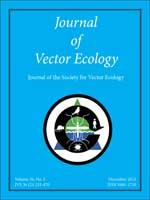Malaria is dependent on environmental factors and considered as potentially re-emerging in temperate regions. Remote sensing data have been used successfully for monitoring environmental conditions that influence the patterns of such arthropod vector-borne diseases. Anopheles atroparvus density data were collected from 2002 to 2005, on a bimonthly basis, at three sites in a former malarial area in Southern Portugal. The development of the Remote Vector Model (RVM) was based upon two main variables: temperature and the Normalized Differential Vegetation Index (NDVI) from the Moderate Resolution Imaging Spectroradiometer (MODIS) Terra satellite. Temperature influences the mosquito life cycle and affects its intra-annual prevalence, and MODIS NDVI was used as a proxy for suitable habitat conditions. Mosquito data were used for calibration and validation of the model. For areas with high mosquito density, the model validation demonstrated a Pearson correlation of 0.68 (p<0.05) and a modelling efficiency/Nash-Sutcliffe of 0.44 representing the models ability to predict intra- and inter-annual vector density trends. RVM estimates the density of the former malarial vector An. atroparvus as a function of temperature and of MODIS NDVI. RVM is a satellite data-based assimilation algorithm that uses temperature fields to predict the intra- and inter-annual densities of this mosquito species using MODIS NDVI. RVM is a relevant tool for vector density estimation, contributing to the risk assessment of transmission of mosquito-borne diseases and can be part of the early warning system and contingency plans providing support to the decision making process of relevant authorities.
How to translate text using browser tools
1 December 2011
Anopheles atroparvus Density Modeling using MODIS NDVI in a Former Malarious Area in Portugal
Pedro M. Lourenço,
Carla A. Sousa,
Júlia Seixas,
Pedro Lopes,
Maria T. Novo,
A. Paulo G. Almeida
ACCESS THE FULL ARTICLE
It is not available for individual sale.
This article is only available to subscribers.
It is not available for individual sale.
It is not available for individual sale.

Journal of Vector Ecology
Vol. 36 • No. 2
December 2011
Vol. 36 • No. 2
December 2011
Anopheles atroparvus
malaria
model
NDVI
Portugal




